What's new
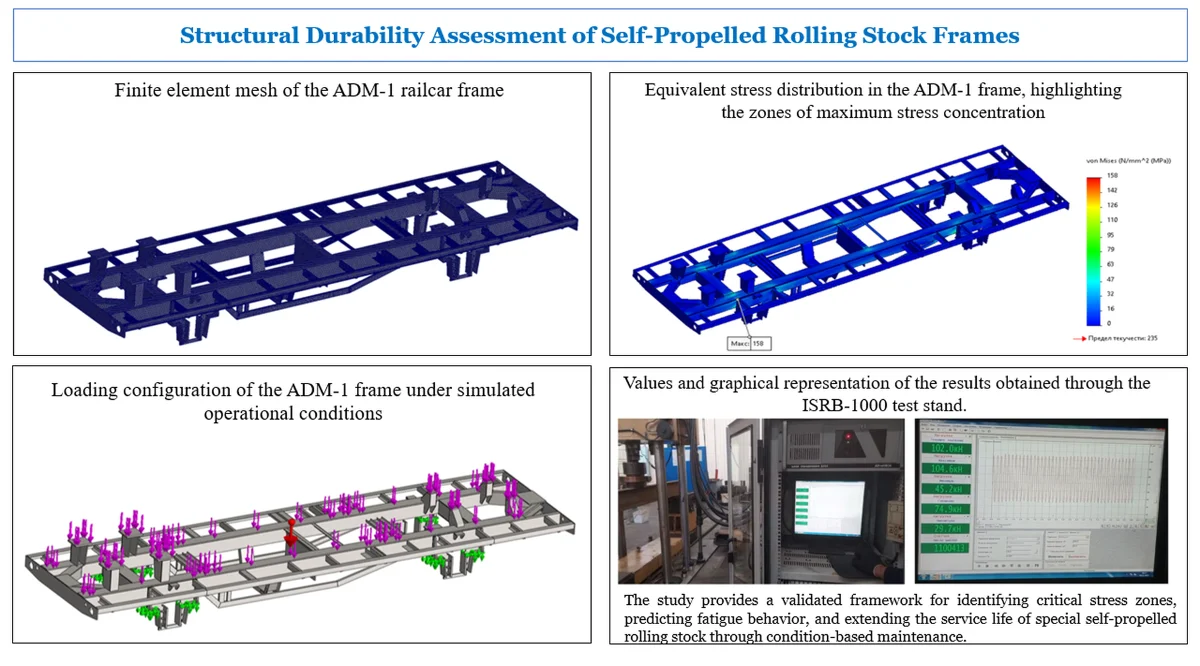
Editor's pick
Research Article
Experimental and finite element analysis of the structural durability of special self-propelled rolling stock frames
By Izzatillo Raxmiddinov, Sherzod Fayzibaev, Yusufov Abdulaziz, You Taiwen, Khusan Kosimov, Nusratillo Abdullayev
The study presents an experimental-numerical assessment of the structural durability and residual life of the ADM-1 self-propelled railcar frame operating under cyclic and static loading conditions. A combined methodology integrating full-scale cyclic bench testing and finite element modeling (FEM) was developed to determine the frame’s stress–strain state and fatigue resistance. The experimental tests, performed at the accredited laboratory of “Quyuv Mexanika Zavodi” JSC using the ISRB-1000 hydraulic loading stand, simulated real operational loads up to 2×106 cycles, equivalent to approximately ten years of service. A detailed FEM model was created in SOLIDWORKS Simulation to replicate these loading conditions, analyze stress distribution, and validate experimental data. The numerical and experimental results showed strong correlation (r > 0.9) with a deviation below 8 %, confirming the accuracy of the proposed approach. The maximum equivalent (von Mises) stresses remained below 0.6σ0.2 for St3sp steel, indicating that the structure operated entirely within the elastic range and met the strength requirements of GOST 31846-2012. Fatigue life estimation using Miner’s cumulative damage rule yielded a damage factor of D= 0.72, corresponding to 8-12 years of effective service life, with a residual fatigue resource of approximately 35-40 %. The developed hybrid methodology provides a reliable framework for condition-based maintenance and life-extension of special self-propelled rolling stock.
December 22, 2025
Applied Physics
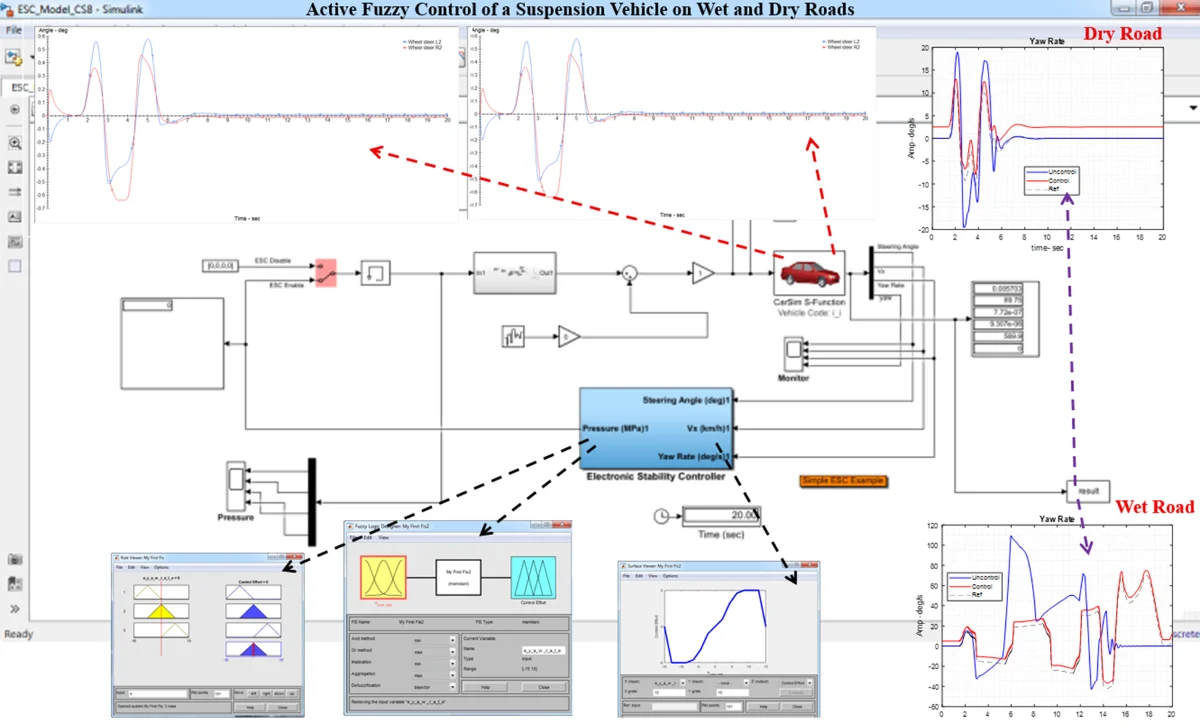
Research Article
Active fuzzy control of a suspension vehicle on wet and dry roads
This paper presents a co-simulation of MATLAB and CarSim to control and model a vehicle suspension system under different road surface conditions, either wet or dry, using an active fuzzy controller in MATLAB. CarSim is a professional vehicle simulation software capable of modeling nonlinear car dynamics with various uncertainties. These uncertainties are addressed by the fuzzy set approach due to its qualitative and robust control capabilities, effectively handling noise, disturbances (such as road conditions), and unknown parameters in CarSim’s vehicle model. The design of an active steering controller and rotational torque system using a fuzzy controller is crucial for enhancing road safety, especially given the increasing number of vehicle crashes. The research methodology varies based on the study's purpose, nature, and implementation capabilities. Accordingly, this research focuses on designing an integrated controller for an active four-wheel-drive system and direct rotary torque control using a fuzzy control method in the MATLAB Simulink environment. This study is analytical and functional, utilizing CarSim for simulation. A fuzzy logic-based integrated control system was designed for steady-state control to improve vehicle stability and steering. The controller adjusts the steering angle and torque to regulate the vehicle’s angular velocity and slip angle under various conditions. As tire performance changes during different maneuvers, the controller dynamically adapts its output to maintain optimal operation within the effective performance range. The significance of using fuzzy logic lies in its ability to handle non-linearity without requiring approximation, ensuring high accuracy. Additionally, it delivers excellent results in enhancing vehicle stability. The findings indicate that the controller significantly improves the vehicle’s dynamic behavior across different driving maneuvers compared to an uncontrolled vehicle.
December 31, 2025
Informatics
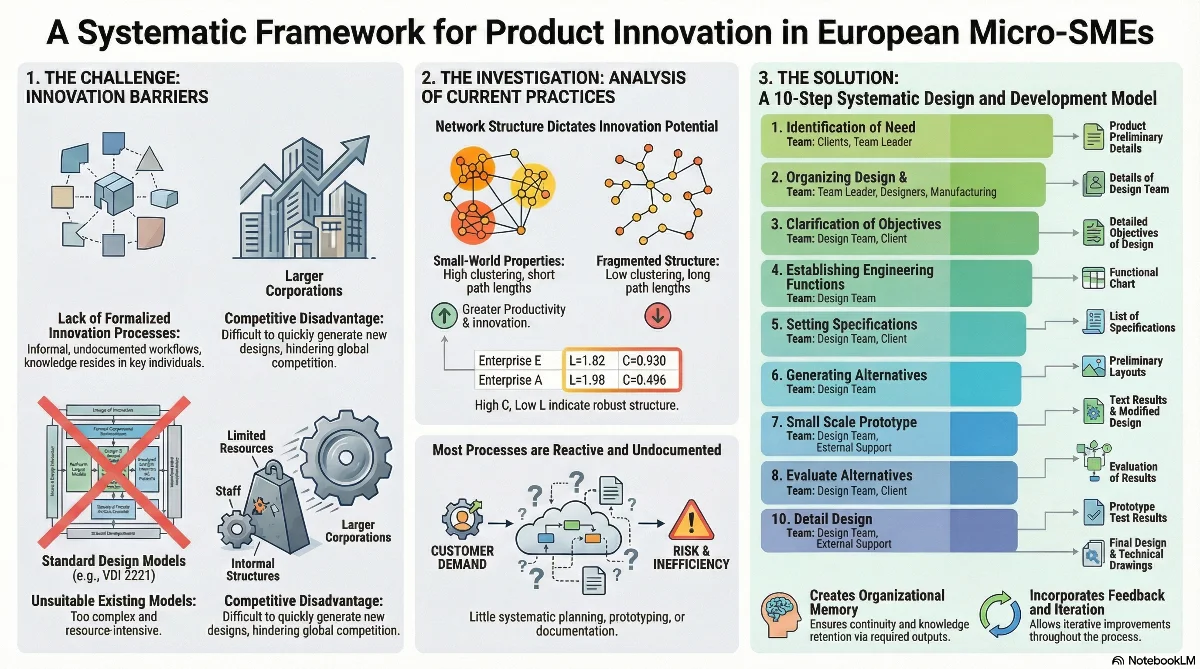
Research Article
Advancing product and process innovation through knowledge-sharing networks among European industrial SMEs
A methodical approach is created in this study to aid SMEs across Europe (Turkiye, UK, Belgium, Italy) in their product and process development endeavors. Methods and processes that must be followed are examined and streamlined, starting from the point of client contact, and ending with establishment of a pilot production line. This study provides strategies to help technicians and engineers create excellent product designs. Though most of the concepts and methods it will produce are anticipated to be applicable to the design of all types of goods, its primary focus is on the engineering-related aspects of product design. The formulation of problems and the conceptual and embodiment phases of design are the main topics of this work. It will support designers in SMEs with problem identification, explanation, and generation and assessment of solutions. To understand their approach and issues, a thorough search in this field is conducted, along with interviews with multiple SMEs. Additionally, to ascertain the SMEs’ network architecture and how their technical employees interact inside these organizations in a way that supports the creation of new products. This will demonstrate these SMEs' advantages or strengthen their creative positions in the face of global competition.
December 31, 2025
Informatics
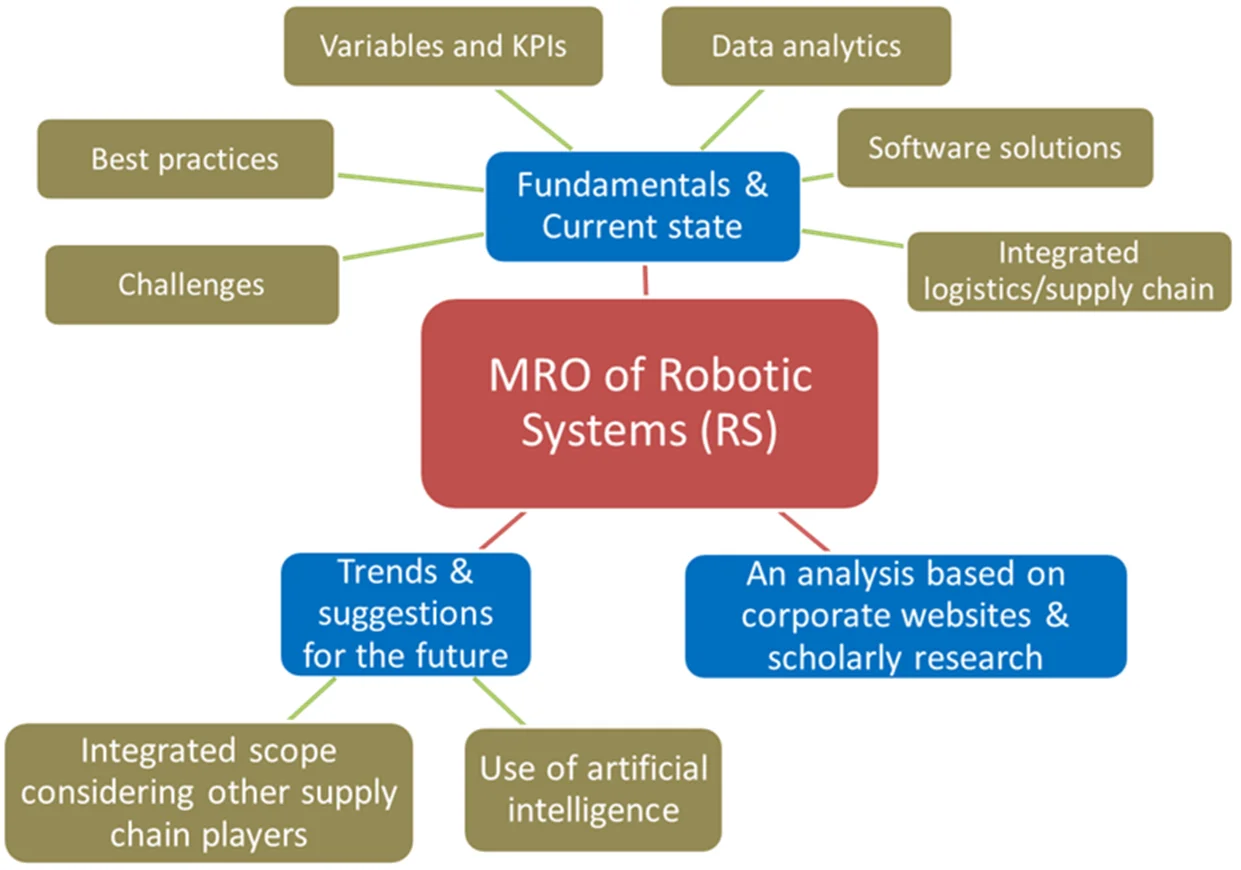
Research Article
Maintenance, repair, and overhaul of robotic systems
This paper not only explores the fundamental aspects of but also brings new ideas for maintenance, repair, and overhaul (MRO) operations of robotic systems (RS). This synthesis is based on the limited scholarly research in this area and on information gathered from comprehensive web searches and analysis of corporate websites so that the results reflect the current views of RS developers and operators. The paper describes several crucial areas concerning RS MRO: maintenance of robotic systems, challenges and best practices for RS MRO, predictive maintenance variables and key performance indicators, data analytics, software solutions for RS MRO, and logistics/supply chain approach that should be considered. These insights provide not only a comprehensive understanding of the current state of RS MRO but also describe trends and suggestions for the future of RS MRO, emphasizing the novelty of the proposed research conducted. Key trends that organizations will need to address include the use of artificial intelligence (AI) models and the increasing importance of RS MRO logistics and supply chain management.
December 29, 2025
Biomechanics

Research Article
Wind stability analysis of the rotating girder segment during construction of a rigid-frame bridge
With China’s rapid infrastructure development, rotating beam bridge technology is widely used for constructing bridges over existing lines and complex terrains. As spans and structural complexity increase, wind-induced instability during rotation – especially for large-span rigid frame bridges – has become a critical concern. This study investigates the wind resistance stability of a rigid frame bridge before and during rotation. Using a static gust wind load model, bending moments, friction moments, and stability coefficients under cross-bridge and longitudinal winds are analyzed, considering dynamic friction and unbalanced weights. Results show that: (1) higher dynamic friction significantly improves stability before rotation, as friction from the spherical hinge resists wind-induced overturning; (2) during rotation, lateral wind dominates cross-bridge stability, while longitudinal stability depends on both wind and unbalanced loads; (3) counterweight adjustment and high-friction coatings effectively enhance anti-overturning capacity. The findings confirm construction safety and provide valuable references for wind-resistant design in similar rotating bridge projects.
December 22, 2025
Vibration Engineering
Latest from engineering

Research Article
Die casting mold design of CH367B1 aluminum alloy throttle valve body
As a core component of the automotive engine intake system, the throttle valve body is subjected to long-term engine vibrations. Defects such as gas pores and shrinkage pores in the die-cast part will cause uneven stiffness of the throttle valve body, and thus lead to fatigue failure due to local stress concentration under vibration loads. In this paper, the aluminium alloy was used as the die-casting alloy to design an efficient and simple die-casting mould for CH367B1 aluminium alloy throttle valve body. After measuring the target dimensions and conducting a preliminary analysis of the UG 3D drawing of the part, the size and structure of the valve body were analysed according to the 3D model of the part to select the appropriate parting surface. In the design process, the clamping force, chamber capacity, projected area and other parameters were calculated in order to select a suitable die-casting machine. Part-related dimensions and features were analyzed. Push-out mechanisms, molded parts, guide mechanisms, etc. were designed. The whole set of molds was obtained. Suitable casting systems were designed by calculating and checking references. Mold flow analysis was carried out using ProCAST2021 software. The optimal solution was selected by observing the liquid metal filling process and the distribution of defects, and then calibrated.
December 22, 2025
Informatics
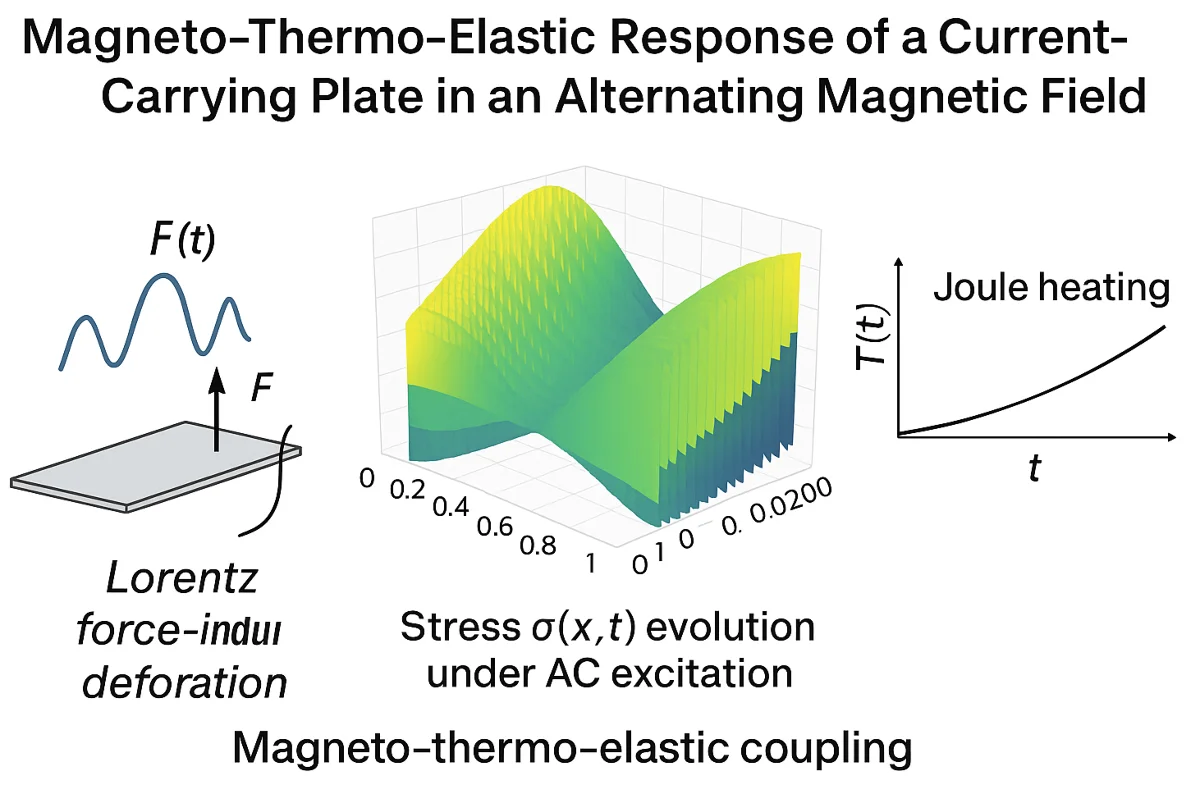
Research Article
Magnetoelastic oscillation of current-carrying plates in an alternating magnetic field
Modern technological advancements, particularly in micro- and nanoelectronics, aerospace engineering, sensor systems, and robotics, necessitate a deeper understanding of how structural elements behave under various physical influences. One significant and relevant phenomenon is magnetoelastic interaction, which involves how the mechanical behavior of current-carrying elastic bodies is affected not only by external loads but also by internal electromagnetic processes. Current-carrying plates, commonly utilized in micro- and nanoelectronics, respond to external fields by altering their stress-strain states. To accurately model these processes, an integrated approach is required that considers mechanical, electromagnetic, and thermal effects caused by electrical currents. This paper focuses on the mathematical modeling and numerical study of transverse magnetoelastic oscillations in thin current-carrying plates subjected to an alternating magnetic field. The problem is formulated considering electromagnetic interactions, geometric nonlinearity, and external alternating currents. A comprehensive system of equations is developed that includes the equations of motion, Maxwell's equations, and the heat equation with Joule heating sources. For the numerical solution, the finite difference method using the Newmark scheme and discrete orthogonalization techniques are applied. Graphs illustrating stress and strain distributions are presented, and the effects of magnetic field frequency and external current on the system’s behavior are analyzed. This research is vital for designing reliable components in micro- and nano-electronics and aviation.
December 22, 2025
Computer Science
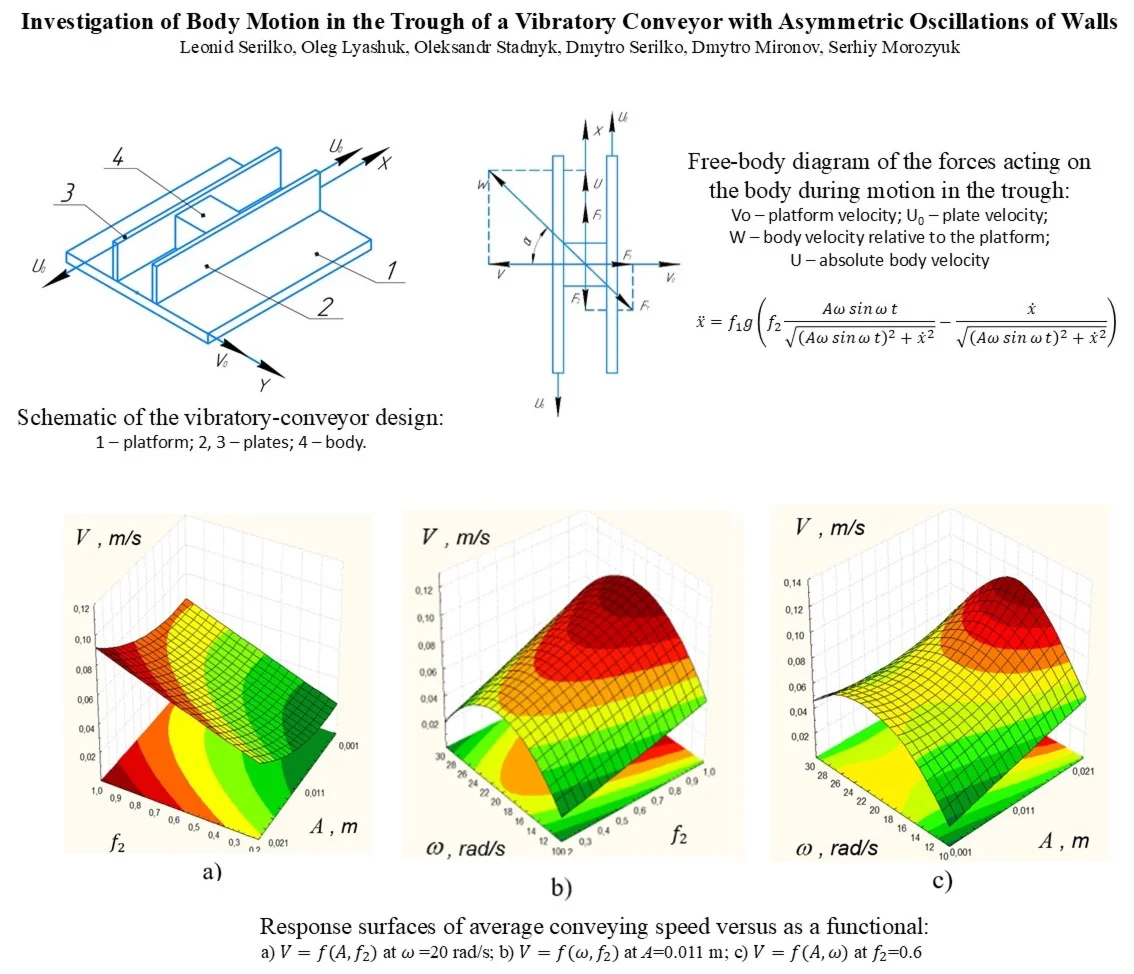
Research Article
Investigation of body motion in the trough of a vibratory conveyor with asymmetric oscillations of walls
The transport of material by vibratory conveyors involves micro-throws of particles, which can be undesirable for certain materials. This study investigates body motion in a conveyor trough whose bottom executes harmonic oscillations perpendicular to the transport direction, while the side walls undergo asymmetric oscillations. The methodology combines mathematical modelling and laboratory experiments. Numerical integration of the governing differential equations using a fourth-order Runge-Kutta scheme yielded the body displacement over one oscillation period, which enabled estimation of the average conveying speed and, consequently, the throughput. The study substantiates the concept and demonstrates the feasibility of the proposed vibratory-conveyor architecture. The results can inform the design of conveyors with throughput regulated by adjusting oscillation frequency or amplitude.
December 22, 2025
Vibration Engineering
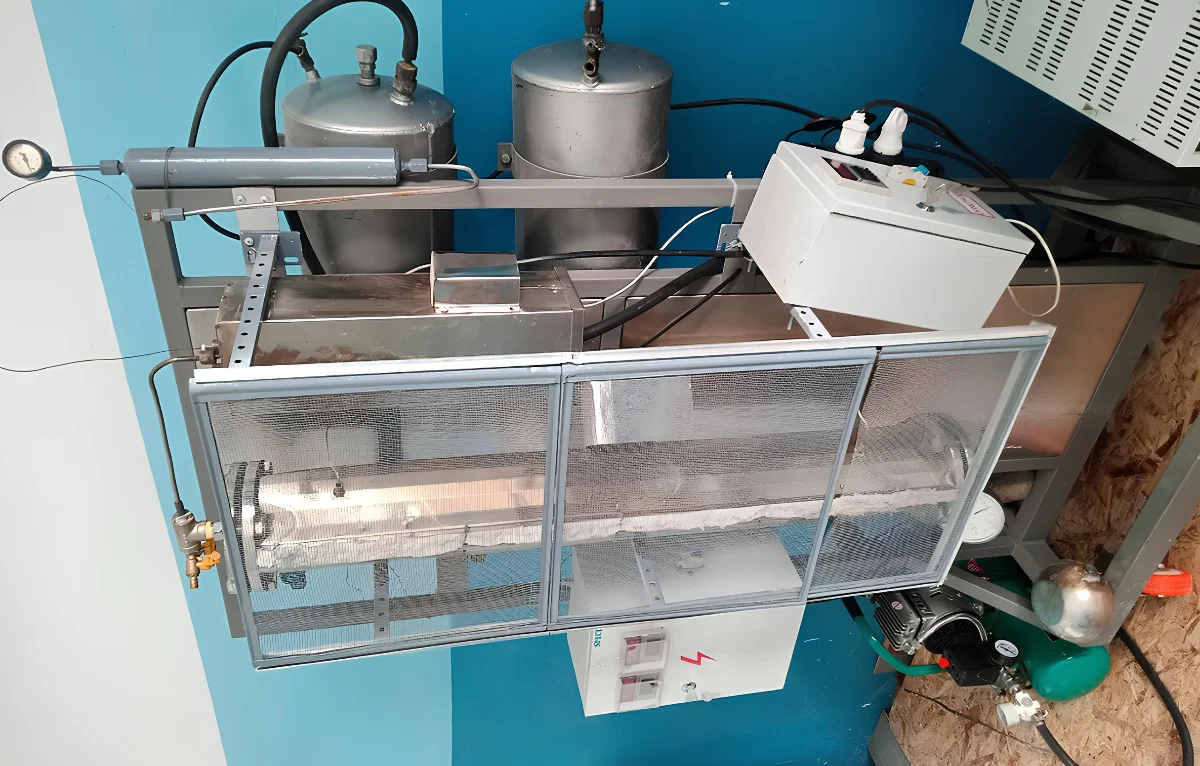
Research Article
Design and development of an innovative laboratory setup for the restoration of dynamic activity in spent zeolites
This work presents the development of an innovative laboratory installation for the regeneration of spent zeolites used in the purification of natural and wastewater from heavy metal ions and other pollutants. The technological scheme of the installation is described, enabling efficient restoration of the dynamic activity of zeolite sorbents, which ensures their multiple reuse and reduces dependence on imported synthetic sorbents. The possibility of reusing eluates obtained during regeneration as components of electrolytes for electroplating processes is considered. The technical characteristics of the installation are provided, and the application areas of regenerated zeolites are described, including gas stream purification, fuel drying, and transformer oil dehydration. The expected effect of implementation is the optimization of regeneration modes, reduction of waste, and an increase in the environmental safety of production processes.
December 22, 2025
Applied Physics
Recently published
Research article
December 22, 2025
Improving the technical and economic performance of diesel engines for shunting locomotives
By Bahodir Kulmanov, Vladimir Grachev, Otabek Ergashev, Shohijakhon Kudratov
Recently published
Research article
December 22, 2025
Application of predictive maintenance models for aircraft engine reliability and safety enhancement: a case of civil aviation in Uzbekistan
By Umarov Farhod Umirovich
76th International Conference on VIBROENGINEERING
Seismic Safety, Construction Digitalization and Sustainable Engineering
Date
April 28-29, 2026
Submission deadline
3/1/2026 11:55:00 PM
Conference format
Hybrid
Best of engineering
Editor's pick
Research article
December 20, 2025
Design of a composite repetitive controller for grid-connected inverters with a notch filter
By Fen Liang, Xiao Liang, Huanke Cheng, Ho-Joon Lee
Editor's pick
Research article
October 31, 2025
Application of GSABO-VMD-KELM in rolling bearing fault diagnosis
By Qiang Li, Chao Wu, Qing Lv, Jin Wang
Editor's pick
Research article
September 30, 2025
Modernization of the electromagnetic vibration stand for testing aviation industry products
By Ivan Kolodiy, Oleksii Lanets, Pavlo Maistruk, Iryna Derevenko, Ihor Nazar, Ivan Khomych
Editor's pick
Research article
August 24, 2025
Bearing fault diagnosis based on multi-scale spectral images and convolutional neural network
By Tongchao Luo, Mingquan Qiu, Zhenyu Wu, Zebo Zhao, Dingyou Zhang
You might also like
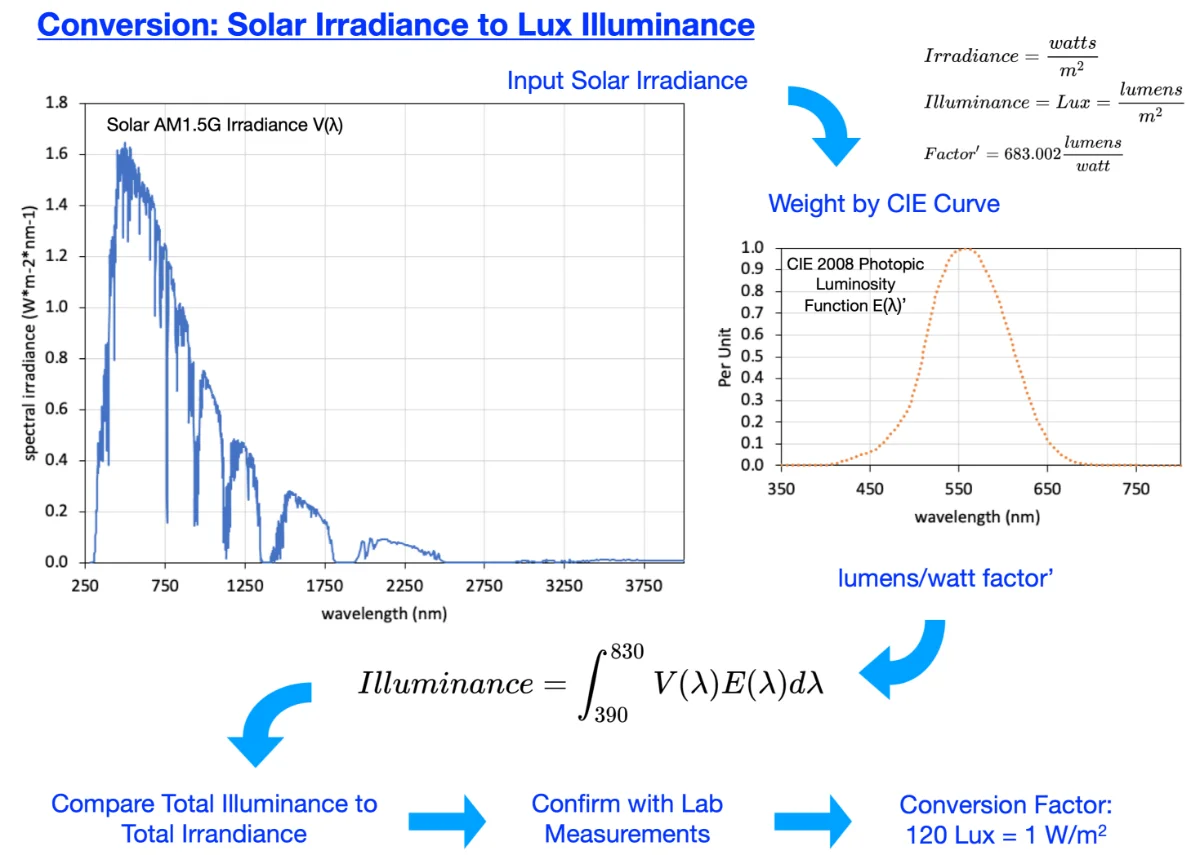
Most downloaded
Research Article
A conversion guide: solar irradiance and lux illuminance
By Peter R. Michael, Danvers E. Johnston, Wilfrido Moreno
The standard for measuring solar irradiance utilizes the units of watts per meter squared (W/m2). Irradiance meters are both costly and limited in the ability to measure low irradiance values. With a lower cost and higher sensitivity in low light conditions, light meters measure luminous flux per unit area (illuminance) utilizing the units of lumens per meter squared or lux (lx). An effective conversion factor between W/m2 and lx would enable the use of light meters to evaluate photovoltaic performance under low solar irradiance conditions. A survey of the literature found no definitive and readily available “rule of thumb” conversion standard between solar irradiance and illuminance. Easy-to-find Internet sources contain conflicting and widely varying values ranging from 688449 to 21000 lx for 1000 W/m2 (1 Sun) of solar irradiance. Peer-reviewed literature contains Luminous Efficacy equivalent values ranging from 21 to 131 lx per W/m2. This manuscript explores the relationship and establishes a theoretical and laboratory measurement guide for the conversion between solar irradiance and illuminance. The conversion factor includes standards data, equipment calibration accuracy, and uncertainty estimates. Solar Irradiance of 1 Sun (1000 W/m2) for an LED-based solar simulator is (116 ± 3) klx and (122 ± 1) klx for outdoor sunlight.
December 4, 2020
Applied Physics
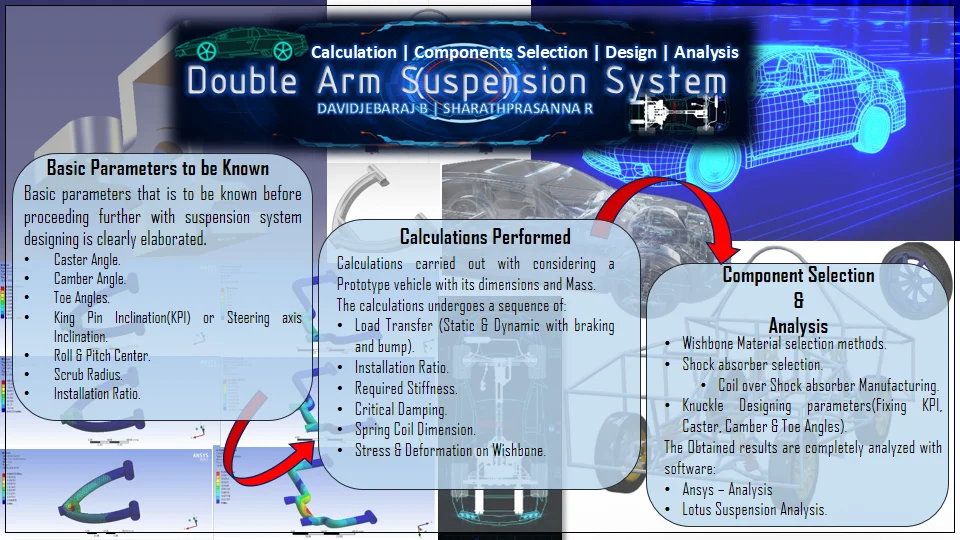
Most downloaded
Research Article
Design and calculation of double arm suspension of a car
By David Jebaraj B, Sharath Prasanna R
Suspension system is one of the challenging portions in designing a vehicle. The complete stability of the vehicle under dynamic conditions depends on the suspension system of the vehicle. Suspension system of a vehicle is interlinked with other systems such as steering, Wheels and Brakes. The main objective of this document is to provide complete guidance in designing and calculation of an independent suspension system with double control arms. The required parameters are calculated on considering a prototype vehicle with gross weight of 350 kg such as required stiffness of shock absorbers, Ride frequency, Motion ratio, Coefficient of damping etc. A CADD model was made with CATIA v5 r20 and SOLIDWORKS on the basis of calculations obtained and stress analysis was carried out for this model in various software such as Ansys. The complete assembled model was tested in LOTUS Shark and the result was obtained.
June 30, 2020
Industrial Engineering
Modal finite element analysis of PCBs and the role of material anisotropy
Printed Circuit Boards (PCBs) are epoxy resin-impregnated and cured sheets of counter woven glass fabric (e.g. FR4) laminated between thin sheets of Copper. The nature of the PCB is inherently anisotropic and inhomogeneous but previous modal FEMs of PCBs have assumed isotropic, anisotropic (transversely isotropic and orthotropic) material properties and shown good correlation with test data for specific scenarios [1-3]. This paper details part of a research program aimed at gaining a better understanding of accurately modeling PCB’s dynamic behavior. New investigations into the impact of material anisotropy and, in particular, the effect of material orthogonal plane definition (Ex and Ey) on eigenfrequencies is analysed. A modal FEM of a JEDEC PCB is created, verified, and validated using well established theories by Steinberg and empirical data by others [4, 5]. The relative contributions of Ex, Ey and Ez on PCB eigenfrequencies is examined using a parametric modal FEM, analysing the role of material isotropy verses anisotropy. The impact of transversely isotropic material properties is also analysed for a typical JEDEC PCB. This analysis details the mesh density required for accurately modeling the PCB eigenfrequencies. The results show that a 100 % increase in Ez has only a 0.2 % difference in the eigenfrequency where as a 100 % increase in Ey has a 1.2 % difference in the eigenfrequency. The effect of orthotropic plane definition (alternating Ex with Ey) on the JEDEC PCB amount to a 7.95 % delta in eigenfrequency.
Coilgun design and evaluation without capacitor
Capacitors with high voltage and capacity values are used in most induction coilguns that are designed and constructed. The fact that capacitors are quite bulky and slow in energy transfer and how a coilgun can be made without using capacitors is the study subject of this article. Two and four coil gun samples were made to find the essential components of an electric gun, and the results are reported in this article. The accuracy of the results is also confirmed by FEMM analysis for these models. The harmony of experimental and theoretical results shows that smaller and low cost portable electrical weapons can be a powerful alternative to firearms in the future.